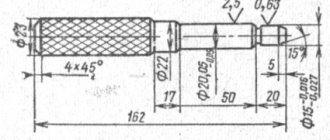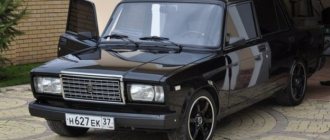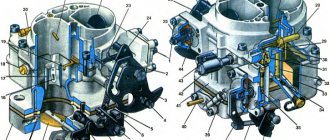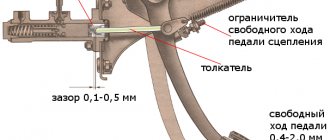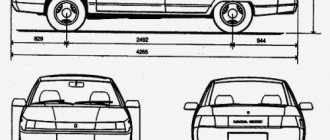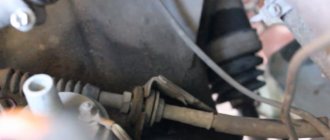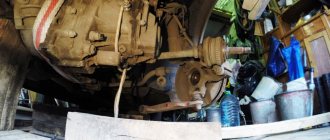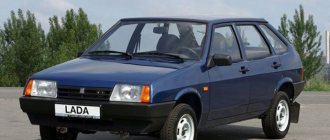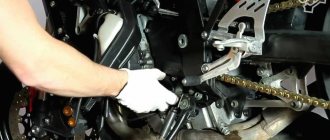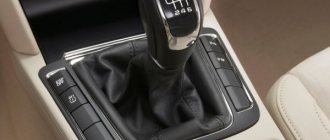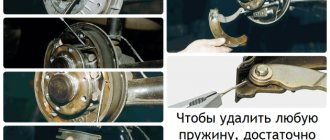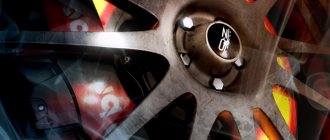DIY clutch and clutch disc repair
The clutch of a passenger car performs an important function. This mechanism protects the gearbox (gearbox) and all its gears, bearings, and shafts from premature wear, tooth breakage, and metal abrasion. The friction linings of the disc wear out over time. For further full operation it is necessary to replace them and repair the clutch.
How does the mechanism work?
The clutch disconnects the engine flywheel from the transmission and, together with the gearbox synchronizers, allows you to smoothly, without shock, change gears on rotating shafts.
Without it, it is impossible to change gear, since gears of different speeds rotate at different speeds during movement. Thanks to the mechanism, when it is turned off, the engine continues to rotate the crankshaft, the gearbox stops briefly, allowing you to engage the next gear at that moment.
Manufacturers install single-disc dry, permanently closed devices on passenger cars. They have a central diaphragm pressure spring with vibration dampers, which are located on the driven disk. The driving half of the clutch is a non-separable part. It consists of the following parts:
- casing;
- pressure disk;
- diaphragm pressure spring.
The housing is attached to the flywheel with bolts and pins. The pressure plate is connected to the casing by steel plates. Each of them is riveted to the casing on one side, and to the pressure plate on the other. The pressure plate is connected to the outer part of the diaphragm spring using clamps. Two round rings serve as support for it. They are secured with stepped rivets to the casing body.
The driven disk is made of steel and has radial slots dividing it into 12 sectors, which are bent in different directions. Friction linings, independent of each other, are riveted to the sectors. A damper that dampens torsional vibrations connects the driven disk to the hub. The system has a hydraulic shutdown drive.
Clutch hydraulic drive device:
- main cylinder;
- clutch release cylinder;
- bearing;
- fork;
- reserve tank;
- a pedal having a servo spring;
- The tank with the drive cylinders are connected to each other by pipelines.
Signs of wear
- The appearance of friction lining odor. Either the feredos are severely worn out, or oil has come into contact with them.
- Shortened clutch pedal travel.
- Airy hydraulic drive or leakage of working fluid.
- Jerks when changing gears.
- The car “grabs” speed at the last highest point of the clutch pedal.
- The clutch is not fully depressed, it is driven.
- Upshifts are engaged without problems, downshifts are impossible to catch.
If at least one of these symptoms appears, you should urgently contact a car service center or repair the discs yourself.
Repair
Replacing a worn clutch disc with your own hands, if you have all the tools, involves the following operations:
- install the machine on a lift, pit, overpass, or lift it with a reliable winch;
- remove the gearbox by disconnecting the wires from the battery, following the procedure:
- drain the oil, remove the starter, disconnect the block with wires from the speed sensor;
- unscrew the bolt of the ignition module bracket, two bolts securing the gearbox to the internal combustion engine;
- disconnect the wire block from the reverse sensor on the bottom;
- unscrew the bolt of the gear shift rod bracket clamp;
- move back and remove the rod from the hinge, remove the wheel drives;
- to prevent the differential from falling out, insert the plugs and tie them down;
- unscrew the nut securing the gearbox to the internal combustion engine from below;
- unscrew the three bolts, remove the lower hatch of the clutch housing;
- at the bottom left, unscrew the bolt securing the gearbox to the internal combustion engine, hang the engine with a hoist;
- unscrew the left and rear engine mounts;
- by inserting a screwdriver between the clutch housing and the internal combustion engine block, move the gearbox off the guide bushings, the input shaft comes out of the clutch;
- The gearbox is lowered down and removed from under the car;
- Use a spanner to unscrew the casing bolts and remove the basket with the disc.
With the clutch removed, it is necessary to check the condition of the disc, bearing, and springs. Worn or faulty parts must be replaced. Take the opportunity to clean and lubricate all rubbing parts.
The disk surfaces must be dry, without burrs or cracks.
After repairing the clutch, replacing as many unusable components as possible, reassemble the gearbox in the reverse order and install it in the car.
Conclusion
Replacing the disc is done, you can continue to operate the car. Now he shows miracles. Gear shifts smoothly, silently, knocking and jerking have disappeared. Pulling away is a pleasure; the car obeys without question. The success of such a repair is that the disk replacement is done with your own hands.
Re-riveting driven disk linings
To replace worn friction linings of driven disks, you must:
- drill or cut off the rivets with a pointed chisel and remove the linings; Drill out the rivets carefully so as not to damage the holes in the disk;
- place a new lining on the disk, mark the centers of the holes, drill holes and countersink them so that the rivet heads are 0.5 mm from the surface of the lining;
- select brass or copper rivets according to the diameter of the disk holes and the thickness of the assembled disk with linings so that the length of the protruding part of the rivet is approximately equal to 0.7 of its diameter;
- rivet the linings to the disk manually or using a bench tool with frequent and strong blows (so that the heads of the rivets on both sides are buried 0.5 mm from the surface of the linings).
Rice. Bench device for riveting clutch disc linings.
After riveting, the surfaces of the linings are cleaned with a file or emery stone and the disc is checked for runout in the centers on the mandrel. The runout from the short end of the disk hub at a radius of 120-150 mm should not exceed 0.5 mm. If the runout is greater than the specified value, the disc is straightened on the plate with hammer blows.
The linings of the driven clutch disc (for GAZ-51 and M-20 Pobeda cars) are riveted to leaf springs located around the circumference of the disc. In this case, each overlay is riveted separately.
Chainsaw
The woodworking machine's clutch is centrifugal and automatically engages when the engine speed changes. If the speed is low, the elements of the mechanism are pressed against the shaft. Thus, the rotational motion is not transmitted to the sprocket. As the speed increases, the elements move apart and are pressed against the drum, thereby causing the chain to rotate.
A characteristic feature of this type of device is braking, where the chain slows down. This way it turns out to avoid some glitches. But still, this system is subject to enormous load, so it is necessary to systematically carry out preventive inspection and repair.
How does a chainsaw engine work?
The devices released in the near future have a single-cylinder, two-stroke, carburetor-type engine. Or rather, how to unscrew the clutch cup on a stihl. How to remove the shaft on a trimmer. It contains several devices that work harmoniously. Replacing the clutch on a lawn mower. hd. #clutches, #how to remove the clutch. Main components of the motor:
- Flywheel;
- coupling;
- Incendiary module;
- Muffler;
- Mounting sleeve.
The engine installed in the saw operates at a frequency of 13.5 thousand revolutions/minute, and therefore requires treatment with high-quality oil. A high level of system cooling is required during operation. The engine of the unit is equipped with a cooling system that supplies air to cool the systems.
Brushcutter repair and review.
Design features
Clutch basket is the popular name for the pressure plate, which is an integral part of the car transmission. It is a structure with a convex round base, into which pressure springs are built-in.
These elements are connected to a special round platform called a clamping platform. It has a smooth, sanded surface on one side to ensure a tight surface fit. From the center of the basket there are special pressure springs attached to the flywheel.
The purpose of a car's clutch assembly is to smoothly connect the flywheel of the car's power unit and the gearbox shaft. This is done by connecting a disk (in other words, a basket) to the driven element.
There are single-disk mechanisms with one driven disk and multi-disk ones. Most cars have a single-disc design. There are also dry and wet mechanisms. Wet works in an oil environment. Most of the components installed in the machines are dry.
According to the method of actuation, clutch mechanisms are divided into mechanical, electrical, hydraulic and combined. Nowadays, most cars are equipped with manual varieties.
Chainsaw clutch
The clutch of the device for processing wood is centrifugal and is activated automatically when the engine crankshaft speed changes. If the speed is low, then the elements of the mechanism are pressed against the shaft. This way the rotational motion is not transferred to the sprocket. As the speed increases, the elements spread out and are pressed against the drum, thereby causing the chain to spin.
A corresponding property of this type of device is braking when the chain slows down. This way you can avoid any damage. But still, this system is subjected to heavy load, so it is necessary to systematically carry out preventive inspection and repair.
How to remove
The drive sprocket also serves as a drum. The coil on the trimmer has stopped rotating in order to remove it. And if it’s behind the clutch cup. One of the main reasons for the breakdown of this block is the grinding of the sprocket teeth. In a solid drum version, the chain may cut through the sprocket during operation. This mechanism requires replacement. If the drum has a replaceable crown, it must be removed and replaced during maintenance. After which the drum can continue to operate.
When there is a need for repairs, you should seek help from a service center where experienced specialists work. But if there is no such thing nearby, the question arises - how to remove the clutch without the help of others? If you have the necessary set of tools, you can easily implement your plans. Of course, there are some differences in models from different companies, but the disassembly scheme remains the same:
- First, remove the chain brake cover by turning the lever. Lightly unscrew the nuts to release the tension on the chain. After loosening, you can completely unscrew the nuts and remove the cover;
- The chain and guide bar are disassembled, as well as the mechanism is cleaned of dirt;
- The cylinder head spark plug is turned out and the piston is fixed. To do this, the crankshaft must be rotated until the exhaust port is blocked, and then a piece of rope is placed in the cylinder to lock the piston. After completion of the work, the rope is removed from the mechanism;
- The nuts on the clutch are unscrewed using the special wrench included in the kit. In this mechanism they are made with a left-hand thread, and this must be taken into account when dismantling. After this, the mechanism is disassembled and all its parts are inspected for damage. Although I already have it on my trimmer in order to remove the clutch assembly once as in the photo. I hope my tips on how to remove the mowing head on the Black&Decker GL716 trimmer How to replace. Worn parts must be removed and replaced with new ones.
After repairs and replacement of parts, it is necessary to reassemble in the reverse order. The disassembly process is presented in more detail in the video.
In order to independently repair such chainsaws as Shtil, Husqvarna, Partner, Goodluck, you need to know some of the features of the models. For example, some types of saws have a washer installed (between the drive sprocket cup and the motor). During assembly, it must be installed in its original place.
If the model is equipped with a special spring that transmits rotation to the pump drive, then its correct installation after repair is extremely important. Otherwise, the device may be seriously damaged. After preventive and repair work, it is necessary to check whether the mechanisms are working properly.
How to change the clutch on a VAZ 2110, 2111, 2112
1). Loosen the mounting bolts on the left wheel. We jack up the front part of the wheel and place it on the sawhorses.
2). Remove the wheel and unscrew the 2 bolts securing the lower ball joint.
3). Remove the negative terminal from the battery.
4). We remove the mass air flow sensor (mass air flow sensor), loosen the clamp that secures the mass air flow sensor corrugation, and take out the air filter.
5). Remove the clutch cable from the clutch fork. Loosen the two fastening nuts that secure the cable to the bracket on the gearbox.
6). We unscrew the bolt that secures the starter to the box, and remove the first bolt securing the gearbox.
7). We find the second mounting bolt on the gearbox and release it. We also loosen the top bolt that secures the starter.
8). Remove the connector from the speed sensor and unscrew the speedometer cable.
9). We dismantle the longitudinal extension and the lever.
10). Unscrew the bolt that secures the starter.
eleven). Remove the 3rd gearbox mounting bolt. Unscrew another nut located near the right CV joint.
12). Remove the torque rod mounting bolts. There are two of them.
13). We loosen the nut, which is located on the clamp of the gearbox control drive rod, and remove the rod from the box.
14). We install the support under the engine, unscrew the 2 nuts that secure the rear cushion (the point of this is to avoid a possible breakthrough of the hoses).
15). Carefully remove the gearbox from the engine and release it to the floor. It should hang on the axle shafts.
16). As an option: we immediately replace the clutch release bearing.
17). We assess wear, replace the disc, install a new clutch basket if necessary, and check the paddles.
18). We perform assembly in reverse order.
Video
How to change clutches on Lada Priora?
1). We drive the car onto the overpass.
2). We remove the battery.
3). Disconnect the cable going to the speedometer.
4). We remove the gearbox and if you plan to put back the old pressure plate, then to maintain balance, you need to note the relative position of the flywheel and the casing of the above-mentioned disc
5). Next, insert the mandrel into the hole in the disk. You can do without this procedure, but then you need to hold the driven disk, otherwise it will fall out.
6). Holding the flywheel, unscrew all 6 mounting bolts. At the same time, this work must be done gradually, one turn from each bolt, so that the disk does not warp.
Signs of a bad clutch
Driving on domestic roads, traffic jams, abrupt starts at traffic lights, street racing, bad spare parts kill the transmission, and clutch malfunctions occur, among other things. If you continue to drive with a damaged unit, the gearbox will be severely damaged, and repairs will be very expensive.
Therefore, as soon as you notice signs of a clutch malfunction, immediately contact Autorusservice. We have the equipment necessary for diagnostics and repair, spare parts for all popular models of foreign cars in our own warehouse, and most importantly, professional mechanics with 16 years of experience in transmission work.
Let us describe the most common signs of clutch failure:
- gears are difficult to switch (or not switched on at all);
- the car accelerates poorly and slips even at high speeds, and there is a burning smell;
- when the engine is running, an extraneous noise is heard in the gearbox, and it disappears when you press the clutch pedal;
- jerking when clutch operates
- vibration when engaging clutch
- the pedal fails.
Clutch malfunctions that are not corrected in time may result in additional costs for manual transmission repairs!
First, diagnostics are carried out; all parts of the gearbox must be in good working order so as not to harm the new clutch. The clutch is replaced if everything is in order with the manual transmission, so that you do not have to pay twice.
We deal only with mechanical clutches of the following brands
Like a chainsaw engine
The newly released devices have a single-cylinder, two-stroke carburetor engine. It includes several mechanisms that work together. Main engine components:
- Flywheel;
- Connection;
- Incendiary module;
- Muffler;
- Bushing installation.
The motor installed in the saw operates at a frequency of 13.5 thousand revolutions per minute and therefore requires treatment with high-quality oil. During operation, a high level of cooling system is required. The engine of the unit is equipped with a cooling system that supplies air for the cooling systems.
Support the channel. turn off ( AdGuard\AdBlock ) the ad blocker. Please support our channel in any way you can.
how to unscrew the clutch on a chainsaw
for repair how to loosen the grip on the chainsaw for repair.
Chainsaw
The woodworking machine's clutch is centrifugal and automatically engages when the engine speed changes. If the speed is low, the elements of the mechanism are pressed against the shaft. Thus, the rotational motion is not transmitted to the sprocket. As the speed increases, the elements move apart and are pressed against the drum, thereby causing the chain to rotate.
A characteristic feature of this type of device is braking, where the chain slows down. This way it turns out to avoid some glitches. But still, this system is subject to enormous load, so it is necessary to systematically carry out preventive inspection and repair.
How to delete
at the same time the drum. One of the main reasons for the failure of this device is
grinding sprocket teeth. In the monolithic version of the drum, the chain may cut through the sprocket during operation. This mechanism requires replacement. If the drum has a replaceable crown, it must be removed and replaced during maintenance. After this, the drum can continue to operate.
When there is a need for repairs, you need to contact a service center for help, where experienced specialists work. But if there is no one nearby, the question arises. How to remove the clutch yourself? If you have the right set of tools, you can easily implement the plan. Of course, there are some differences in models from different companies, but the disassembly scheme remains the same:
- First, the brake cover is removed by turning a lever. The nuts are slightly twisted to... After loosening, you can completely unscrew the nuts and remove the cover;
- Disassemble the chain and guide, as well as clean the mechanism from contamination;
- The cylinder head is rotated and the piston is locked. To do this, rotate the crankshaft until the relief hole is blocked, and then a piece of rope is placed in the cylinder to stop the piston. When the work is completed, the rope is removed from the mechanism;
- Unscrew the nuts on the coupling using the special wrench included in the kit. In this mechanism they are made with a left-hand thread, and this must be taken into account when dismantling. After this, the mechanism is dismantled and all its parts are checked for damage. Worn parts must be removed and replaced with new ones.
After repairs and replacement of parts, it is necessary to reassemble in the reverse order. The disassembly process is presented in more detail in the video.
To independently repair chainsaws such as Shtil, Huskvarna, Partner, Goodluck, you need to know some of the features of the models. For example, some types of saws have a washer installed (between and the motor). It must be replaced during assembly.
If the model has a special spring that transfers rotation to the pump drive, it is extremely important that it is installed correctly after repair. Otherwise, the device may be seriously damaged
After preventive and repair work, it is necessary to check whether the mechanisms are working properly.
Chainsaw Stihl (Calm). How to use
How to Lubricate the Sprocket on a Chainsaw Bar
How long does the clutch last?
It is impossible to name a specific mileage after which it is time to change the clutch. Too many factors influence its service life:
- driving style - a sharp start and frequent slipping, and even more so, participation in races significantly reduces the period of operation;
- quality of the unit - original parts are always more durable than inexpensive analogues;
- foreign liquids or small solid objects can damage even a new unit;
- errors during installation and adjustment inevitably lead to reduced performance.
Wear of linings due to incorrect clutch settings
Clutch slave cylinder repair
Repair of the clutch slave cylinder must begin with its removal and disassembly. For this you need a vice and a bench tool. After removal, you need to place the working cylinder in a vice to make it more convenient to disassemble it.
Initially, you need to remove the protective cap along with the pusher. After this, it is necessary to remove the piston and remove the retaining ring located on the piston. You need to remove the O-rings and spring from the piston
After this, it is important to clean the air outlet fitting and all the holes that are in the cylinder
Next, you need to make sure that there is no mechanical damage to the cylinder bore and the outer surface of the piston. If there is any mechanical damage to the spring, it must be completely replaced. All O-rings, rubbers and protective caps must be replaced with new ones. After this, you need to rinse all parts with clean brake fluid.
How long does the clutch last?
Clutch problems are rare today and most components are very durable. The drive plate experiences the most stress, but its surface is also designed to last at least 100,000 kilometers. If it has worn out before then it is due to a defect in the area - or the driver. This was not always the case: previously, materials had a very limited service life. Clutch disc lining material has long been made from organic composites with various fillers to improve the coefficient of friction and reduce wear. And, contrary to what is sometimes said, clutch discs are not connected to the brake pads, but are significantly more sensitive to temperature: they begin to dissolve at about 320 degrees.
